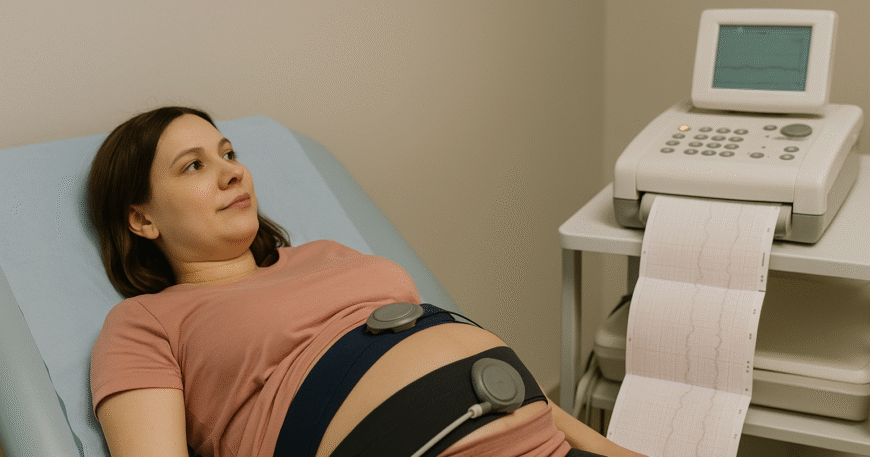
CTG Test in Pregnancy—A Lifesaving Step for Monitoring Your Baby’s Health
When you’re expecting, every heartbeat matters—especially the tiny one growing inside you. That’s where the CTG test in pregnancy comes in. It’s a simple, non-invasive procedure that gives doctors a clear picture of how your baby is doing inside the womb. With the help of a CTG machine, medical teams can monitor the baby’s heartbeat and your uterine contractions in real time. This blog will help you understand what a CTG test is, why it’s important, and how it’s done.
What Is a CTG Test in Pregnancy?
CTG stands for Cardiotocography. It’s a common monitoring tool used during pregnancy, especially in the third trimester or during labor. The CTG test tracks two things:
- The baby’s heartbeat
- The mother’s uterine contractions
The results help doctors assess the baby’s well-being, particularly if there are concerns like reduced movements, high-risk pregnancy, or overdue labor.
If you’ve ever wondered, “What is CTG in pregnancy?” The answer is simple: it’s a way to make sure your baby is healthy, responsive, and getting enough oxygen.
How Does a CTG Machine Work?
The CTG machine uses two sensors placed on the mother’s belly:
- One sensor monitors the fetal heart rate.
- The other tracks uterine contractions.
The machine prints a continuous graph (called a tracing) showing both patterns. Trained professionals read this graph to determine if the baby is in distress, overly active, or stable.
Some machines are digital and wireless, while others are more traditional, but all perform the same vital function—giving insight into the baby’s condition.
When Is a CTG Test Recommended?
Doctors typically recommend a CTG test in pregnancy if:
- The baby is moving less than usual.
- There’s a high-risk pregnancy (e.g., diabetes, high blood pressure).
- Labor has started, and monitoring is needed.
- The due date has passed without signs of labor.
- There is concern about fetal growth or well-being.
In hospitals following NICE guideline CTG monitoring, the test is also used during labor to help guide clinical decisions and ensure a safe delivery.
Types of CTG Monitoring
1. External CTG Monitoring
External CTG monitoring is the most commonly used method. Two belts are strapped around the abdomen and connected to the CTG machine. It’s completely safe and painless.
2. Internal CTG Monitoring
It is utilized in infrequent, intricate circumstances. A small electrode is placed on the baby’s scalp through the cervix. This variant gives a more accurate reading but is only used when necessary.
Understanding the CTG Test in Pregnancy Normal Range
Doctors rely on specific CTG tests and normal pregnancy range data to decide if the baby is doing fine. Here’s what’s considered normal:
- Fetal heart rate: 110–160 beats per minute
- Accelerations: Brief increases in heart rate (a good sign)
- No late decelerations: Drops in heart rate after a contraction could be concerning
If the CTG tracing shows abnormal patterns, doctors may perform additional tests or prepare for early delivery, depending on the case.
Benefits of CTG Electronic Fetal Monitoring
- Provides real-time updates on baby health
- Helps detect signs of distress early
- Assists in decision-making during labor
- Offers peace of mind to expecting parents
In Pakistan, many hospitals now rely on CTG electronic fetal monitoring systems to ensure safe deliveries. The technology has become more accessible and is considered a standard part of modern maternity care.
CTG Machine Price in Pakistan: What to Know
If you’re curious about the CTG machine price in Pakistan, it can range from PKR 150,000 to PKR 500,000 depending on the brand, features, and whether it includes wireless connectivity or built-in software. Most hospitals and maternity clinics invest in high-quality machines to ensure accurate fetal monitoring.
What Happens During the CTG Procedure?
The CTG procedure is simple:
- You’ll lie down or sit in a semi-reclined position.
- Two belts are placed around your belly.
- The machine starts recording, usually for 20–40 minutes.
- If needed, the test may continue longer, especially during active labor.
It’s non-invasive, doesn’t hurt, and allows you to rest while the monitoring happens.
Shaafi Hospital Alipur Islamabad and CTG Monitoring
At Shaaf Hospital Alipur Islamabad, we use high-end CTG machines to offer both standard and advanced fetal monitoring. Our team follows NICE guidelines for CTG monitoring and provides clear communication throughout the procedure. For us, the well-being of both mother and child is a top priority.
Facts That Highlight the Importance of CTG Tests
- According to WHO, fetal monitoring during labor can reduce stillbirth rates significantly.
- Research from the Royal College of Obstetricians and Gynaecologists (RCOG) shows that timely CTG monitoring can lower emergency C-section rates.
- A 2021 study in Pakistan revealed that facilities using modern CTG machines saw a 25% decrease in delivery complications.
These facts underline why CTG is considered a lifesaving step in maternal healthcare.
Final Thoughts
The CTG test in pregnancy isn’t just a routine scan—it’s a powerful tool that helps healthcare providers detect potential issues early and make fast decisions that protect both mother and baby. The CTG machine enables real-time assessment of fetal well-being, providing reassurance during a period of excitement and uncertainty.
Understanding the CTG procedure, normal ranges, and how modern hospitals like Shaafi Hospital Alipur Islamabad use this technology can empower expectant parents and build trust in their care.
Sources
- World Health Organization – Fetal Monitoring Guidelines
- NICE Guidelines on Intrapartum Care
- Royal College of Obstetricians and Gynaecologists Reports
- ResearchGate: CTG Use in South Asian Countries
FAQs
1. Is the CTG test safe for the baby?
Yes, it’s completely safe and non-invasive. It only monitors; it doesn’t affect the baby.
2. How long does a CTG test take?
A CTG test typically lasts between 20 and 40 minutes. In some cases, it might go longer if more data is needed.
3. What if my baby doesn’t move during the test?
Doctors might ask you to eat something or gently shift positions to stimulate movement. A repeat test may be recommended.
4. Can I request a CTG test if I feel anxious?
Yes, many hospitals are open to conducting the test for reassurance, especially if you feel reduced movements.
5. Do all hospitals in Pakistan offer CTG?
Not all, but most major hospitals, including Shaafi Hospital Alipur Islamabad, provide this test as part of their maternity services.
Call to Action
Are you concerned about your baby’s movement or the approaching date of your delivery? Visit Shaafi Hospital Alipur Islamabad for trusted CTG monitoring with modern machines and caring staff. We invite you to schedule your appointment today to ensure peace of mind for both you and your baby.
